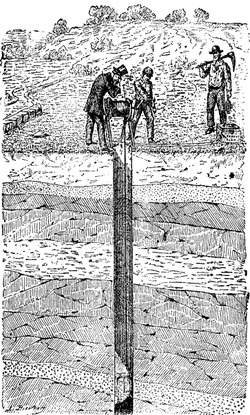An erygmascope is the name given to a late 19th-century electric lighting apparatus designed for the examination of the strata of earth traversed by boring apparatus.
It consisted of a very powerful incandescent lamp enclosed in a metallic cylinder. One of the two semi-cylindrical sides constitutes the reflector, and the other, which is of thick glass, allows the passage of light, which illuminates the strata of earth traversed by the instrument. The base, which is inclined at an angle of 45°, is an elliptical mirror, and the top, of straight section, is open in order to permit the observer standing at the mouth of the well, and provided with a powerful spyglass, to see in the mirror the image of the earth. The lamp is so mounted that its upwardly emitted rays are intercepted.
The whole apparatus was suspended from a long cable, formed of two conducting wires, which winds around a windlass with metallic journals which are electrically insulated. These journals communicate, through the intermedium of two friction springs, with the conductors on the one hand and, on the other, with the poles of an automatic and portable battery. This permits of lowering and raising the apparatus at will, without derangement, and without its being necessary to interrupt the light and the observation.
The erygmascope was described in an 1891 edition of the Scientific American Supplement; it is uncertain of the extent to which it was ever put to practical use.
See also
External links
- Scientific American Supplement, No. 787, January 31, 1891, from Project Gutenberg
